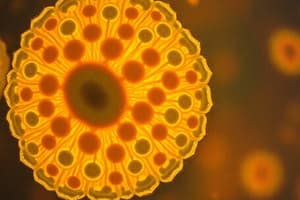Podcast
Questions and Answers
What characterizes prokaryotic cells?
What characterizes prokaryotic cells?
- Their DNA is found in the cytoplasm. (correct)
- They have a true nucleus.
- They are generally larger and more complex.
- They are multicellular organisms.
Which organelle is primarily responsible for protein synthesis?
Which organelle is primarily responsible for protein synthesis?
- Golgi Apparatus
- Lysosomes
- Ribosomes (correct)
- Mitochondria
What is a main function of the Golgi apparatus?
What is a main function of the Golgi apparatus?
- Synthesis of ATP through cellular respiration.
- Identifying and destroying waste materials.
- Modifying, sorting, and packaging proteins. (correct)
- Transporting substances across the plasma membrane.
What type of transport requires energy to move substances across the plasma membrane?
What type of transport requires energy to move substances across the plasma membrane?
Which cell structure is involved in detoxifying harmful substances?
Which cell structure is involved in detoxifying harmful substances?
What role does the nucleus play in the cell?
What role does the nucleus play in the cell?
What is the main function of lysosomes within the cell?
What is the main function of lysosomes within the cell?
What component of the cell membrane allows for communication between cells?
What component of the cell membrane allows for communication between cells?
Flashcards are hidden until you start studying
Study Notes
Cell Structure and Function
1. Basic Cell Types
-
Prokaryotic Cells
- No nucleus; DNA is in the cytoplasm.
- Generally smaller and simpler.
- Examples: Bacteria and Archaea.
-
Eukaryotic Cells
- True nucleus; DNA enclosed within a membrane.
- Larger and more complex.
- Examples: Animal, plant, fungal, and protist cells.
2. Common Cell Structures
-
Plasma Membrane
- Selectively permeable; regulates entry and exit of substances.
- Composed of a phospholipid bilayer with embedded proteins.
-
Cytoplasm
- Jelly-like fluid (cytosol) filling the cell.
- Contains organelles and is the site for metabolic reactions.
-
Nucleus
- Control center; houses genetic material (DNA).
- Site of RNA synthesis (transcription).
-
Ribosomes
- Sites of protein synthesis; can be free-floating or attached to the endoplasmic reticulum.
3. Organelles and Their Functions
-
Endoplasmic Reticulum (ER)
- Rough ER: Studded with ribosomes; synthesizes proteins.
- Smooth ER: Lacks ribosomes; synthesizes lipids and detoxifies.
-
Golgi Apparatus
- Modifies, sorts, and packages proteins and lipids for secretion or delivery to organelles.
-
Mitochondria
- Powerhouse of the cell; site of ATP (energy) production through cellular respiration.
-
Lysosomes
- Contains digestive enzymes to break down waste materials and cellular debris.
-
Peroxisomes
- Breaks down fatty acids and detoxifies harmful substances.
-
Cytoskeleton
- Network of fibers providing structural support and facilitating cell movement and division.
4. Cell Membrane Function
-
Transport Mechanisms
- Passive Transport: Movement without energy (e.g., diffusion, osmosis).
- Active Transport: Movement against the concentration gradient requiring energy (e.g., sodium-potassium pump).
-
Cell Communication
- Receptors on the membrane allow cells to receive signals and respond appropriately.
5. Specialized Cell Types
-
Muscle Cells
- Specialized for contraction; contain numerous mitochondria for energy.
-
Nerve Cells (Neurons)
- Specialized for signal transmission; have dendrites and axons for communication.
-
Epithelial Cells
- Form protective barriers; involved in absorption, secretion, and sensation.
6. Cell Division
-
Mitosis
- Process of cell division resulting in two identical daughter cells; vital for growth and repair.
-
Meiosis
- Specialized division for gamete production; reduces chromosome number by half for sexual reproduction.
Basic Cell Types
- Prokaryotic cells lack a nucleus, with DNA located in the cytoplasm. They are generally smaller and simpler in structure, represented by bacteria and archaea.
- Eukaryotic cells possess a true nucleus, encapsulating DNA within membranes. These cells are larger and more complex, encompassing animal, plant, fungal, and protist cells.
Common Cell Structures
- The plasma membrane is selectively permeable, controlling the movement of substances in and out of the cell; it consists of a phospholipid bilayer containing embedded proteins.
- Cytoplasm is a jelly-like fluid known as cytosol, supporting organelles and serving as the site for metabolic reactions.
- The nucleus functions as the control center of the cell, housing genetic material (DNA) and being the site for RNA synthesis via transcription.
- Ribosomes are the protein synthesis sites, existing either free in the cytoplasm or attached to the endoplasmic reticulum.
Organelles and Their Functions
- The endoplasmic reticulum (ER) is divided into:
- Rough ER, which synthesizes proteins and is marked by ribosomes.
- Smooth ER, which synthesizes lipids and assists in detoxification without ribosomes.
- The Golgi apparatus modifies, sorts, and packages proteins and lipids, preparing them for secretion or transport to organelles.
- Mitochondria serve as the cell's powerhouse, producing ATP through the process of cellular respiration.
- Lysosomes contain digestive enzymes that breakdown waste materials and cellular debris.
- Peroxisomes are responsible for breaking down fatty acids and detoxifying harmful substances.
- The cytoskeleton comprises a network of fibers, providing structural support and facilitating cell movement and division.
Cell Membrane Function
- Transport mechanisms include:
- Passive transport, which requires no energy for movement (e.g., diffusion, osmosis).
- Active transport, which moves substances against the concentration gradient, necessitating energy (e.g., sodium-potassium pump).
- Cell communication occurs through receptors on the membrane that allow cells to detect signals and respond accordingly.
Specialized Cell Types
- Muscle cells are specialized for contraction, featuring numerous mitochondria to fulfill high energy demands.
- Nerve cells (neurons) are designed for signal transmission, possessing dendrites and axons for effective communication.
- Epithelial cells create protective barriers and play crucial roles in absorption, secretion, and sensation.
Cell Division
- Mitosis is the process that results in two identical daughter cells, critical for growth, repair, and cellular regeneration.
- Meiosis is a specialized division for producing gametes that reduces the chromosome number by half, enabling sexual reproduction.
Studying That Suits You
Use AI to generate personalized quizzes and flashcards to suit your learning preferences.




